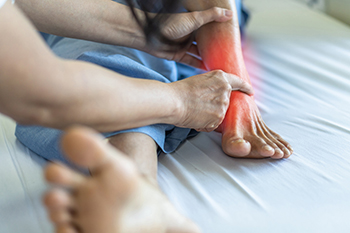
Inside ankle pain, or medial ankle pain, can result from several common causes. One frequent cause is posterior tibial tendonitis, where inflammation affects the tendon supporting the arch. Another potential cause is tarsal tunnel syndrome, a condition involving the compression of the tibial nerve. Medial ankle sprains, typically less common than lateral sprains, can also lead to significant pain and swelling. Preventing inside ankle pain involves strengthening the ankle muscles and tendons through exercises and stretches. Wearing properly fitted, supportive footwear can also help maintain proper alignment and reduce strain. Additionally, avoiding overuse and allowing adequate rest between activities can prevent tendonitis and other overuse injuries. If pain persists, it is suggested that you consult a podiatrist who can offer you effective treatment and prevention strategies.
Ankle pain can be caused by a number of problems and may be potentially serious. If you have ankle pain, consult with Wendy K. Stinson, DPM from New Jersey. Our doctor will assess your condition and provide you with quality foot and ankle treatment.
Ankle pain is any condition that causes pain in the ankle. Due to the fact that the ankle consists of tendons, muscles, bones, and ligaments, ankle pain can come from a number of different conditions.
Causes
The most common causes of ankle pain include:
- Types of arthritis (rheumatoid, osteoarthritis, and gout)
- Ankle sprains
- Broken ankles
- Achilles tendonitis
- Achilles tendon rupture
- Stress fractures
- Bursitis
- Tarsal tunnel syndrome
- Plantar fasciitis
Symptoms
Symptoms of ankle injury vary based upon the condition. Pain may include general pain and discomfort, swelling, aching, redness, bruising, burning or stabbing sensations, and/or loss of sensation.
Diagnosis
Due to the wide variety of potential causes of ankle pain, podiatrists will utilize a number of different methods to properly diagnose ankle pain. This can include asking for personal and family medical histories and of any recent injuries. Further diagnosis may include sensation tests, a physical examination, and potentially x-rays or other imaging tests.
Treatment
Just as the range of causes varies widely, so do treatments. Some more common treatments are rest, ice packs, keeping pressure off the foot, orthotics and braces, medication for inflammation and pain, and surgery.
If you have any questions, please feel free to contact our office located in Parsippany-Troy Hills, NJ . We offer the newest diagnostic and treatment technologies for all your foot care needs.
